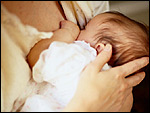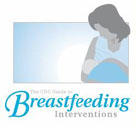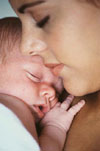Introduction
| CDC is committed to increasing breastfeeding rates throughout the
United States and to promoting and supporting optimal breastfeeding
practices toward the ultimate goal of improving the public's health. In order to achieve these goals, CDC utilizes an evidence-based policy and environmental approach to breastfeeding protection, promotion, and support. CDC’s breastfeeding activities cover a wide range, from conducting and supporting research about breastfeeding to evaluating and sharing information about existing strategies to protect, promote, and support breastfeeding. CDC also works closely with partners and organizations working to improve breastfeeding across the country. |
 |
For Mothers
Breastfeeding: Ideal for Infants
Both babies and mothers gain many benefits from breastfeeding. Breast
milk is easy to digest and contains antibodies that can protect infants
from bacterial and viral infections. Research indicates that women who
breastfeed may have lower rates of certain breast and ovarian cancers.
|
Resources for Improving Maternity Care Practices
Featured Items
 The CDC Guide To Breastfeeding Interventions The CDC Guide To Breastfeeding InterventionsThe CDC Guide To Breastfeeding Interventions provides state and local community members information to choose the breastfeeding intervention strategy that best meets their needs. Support for breastfeeding is needed in many different arenas, including worksites, medical systems, and family settings. |
Does Breastfeeding Reduce the Risk of Pediatric Overweight? Research to
Practice (PDF-1.3Mb)
The health of American children is being threatened by overweight and the
conditions that may stem from this problem, such as elevated serum lipid and
insulin concentrations, elevated blood pressure, type 2 diabetes, and
psychosocial problems. This Research to Practice (R2P) brief explores the
relationship between breastfeeding and pediatric overweight.
The Hospital's Role in Breastfeeding Support
Breastfeeding-Related Maternity Practices at Hospitals and Birth Centers –
United States, 2007
MMWR, June 13, 2008 / 57(23);621—625
Also available in
print-friendly format![]() (PDF-1.67Mb)
(PDF-1.67Mb)
Resources for Improving Maternity Care Practices
-
CDC Guide to Breastfeeding Interventions: Maternity Care Practices
 (PDF-156k)
(PDF-156k) - Hospital Crib Card
Breastfeeding, Maternal & Infant Health Outcomes
![]()
HHS Blueprint for Action on Breastfeeding![]() (PDF-468k)
(PDF-468k)
![]() Please note: Some of these publications are available for download only as *.pdf files. These files require Adobe Acrobat Reader in order to be viewed. Please review the information on downloading and using Acrobat Reader software.
Please note: Some of these publications are available for download only as *.pdf files. These files require Adobe Acrobat Reader in order to be viewed. Please review the information on downloading and using Acrobat Reader software.
* Links to non-Federal organizations found at this site are provided solely as a service to our users. These links do not constitute an endorsement of these organizations or their programs by CDC or the Federal Government, and none should be inferred. CDC is not responsible for the content of the individual organization Web pages found at these links.
Page last updated: July 16 2009
Content Source: Division of Nutrition, Physical Activity and Obesity, National Center for Chronic Disease Prevention and Health Promotion

 Need help breastfeeding?
U.S. Department of Health and Human Services (DHHS) has a
Need help breastfeeding?
U.S. Department of Health and Human Services (DHHS) has a